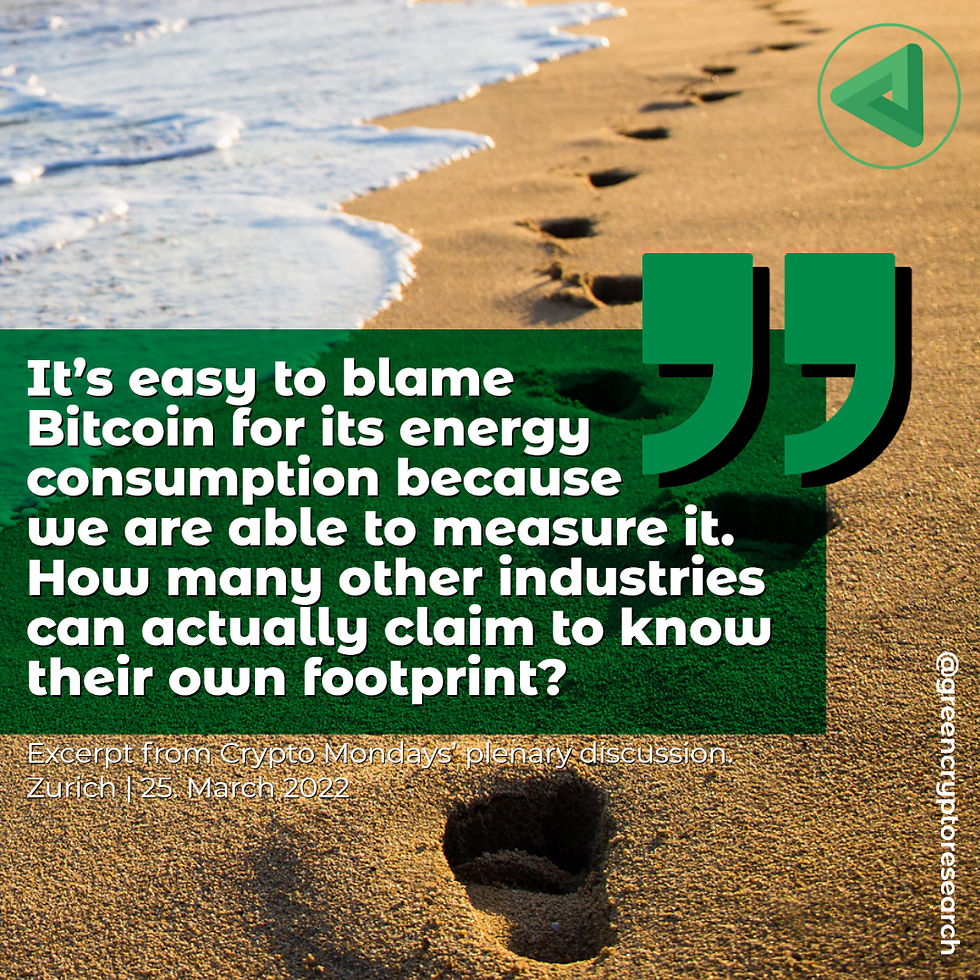Why Green Mining is not the Answer to Bitcoin’s Environmental Problem
- Isabel
- May 23, 2022
- 3 min read
Cryptocurrencies have many benefits. Among the general public, however, they are mainly condemned as environmental offenders. The considerable differences in the environmental impact of the individual coins and tokens are hereby mostly disregarded. While we have already discussed this at length, it will not be the focus of today's article. Instead, we take a look at green mining and why it does not solve Bitcoin’s environmental problem.
When we think about sustainability in holistic ways, carbon emissions do play an important role in the environmental context, but they are not the only factor we need to be mindful of.
The idea behind green mining
Mining refers to the process of adding new blocks to a blockchain and receiving cryptocurrencies as a reward. Cryptos such as Bitcoin or (currently still) Ethereum mined according to the proof of work (PoW) consensus mechanism require a great deal of computational power in a race to solve mathematical problems. The associated power consumption is notoriously immense; Bitcoin mining is known to consume more energy than entire countries per year.
Green mining is based on the idea that the energy required for computing power comes from renewable energy sources. Various financial service providers are intensively studying the current development of green mining projects, as GCR knows first-hand. We are often asked how green mining affects the ESG rating of individual cryptocurrencies - primarily Bitcoin, of course.
Let's get it straight right off the bat: While the idea certainly seems compelling, green mining hardly improves the sustainability of cryptos and the impact on our rating system is so small that it has no change on our environmental score of Bitcoin.
How is that possible if green mining results in a zero-carbon footprint, you may ask yourself. Because it literally sheds light on only one side of the coin.
The environmental impact of electronic waste
When we think about sustainability in holistic ways, carbon emissions do play an important role in the environmental context, but they are not the only factor we need to be mindful of. We also have to look at electronic waste as a crucial side effect of Bitcoin mining. It is completely independent of the energy source and will remain a major challenge until we operate in a fully circular economy.
According to our calculations, Bitcoin mining produces each year 6’000 tons of electronic waste worldwide. This immense figure is mainly due to the computers used, which are optimized specifically for bitcoin mining and can hardly be used for anything else.
In contrast, cryptocurrencies based on proof of stake (PoS) algorithms are much better off environmentally. For example, Cardano produces about 0.3 tons while Fantom only creates 0.1 tons of electronic waste in the same time frame. Here, too, the hardware used plays a role in the lower figures. Cryptos based on the PoS consensus can be validated with normal computers. These have a longer lifespan and can be reused at a later date.
Furthermore, the power consumption per transaction does not decrease just because we change energy sources. Though green mining entails renewable electricity, the same amount of power is consumed, nevertheless. At GCR, we believe that a sustainable world is based on solutions that seek lower energy consumption per se.
ESG Rating of green mined Bitcoins So, what does this mean for the ESG rating of green mined bitcoins? As a quick reminder, Bitcoin is one of the most environmentally damaging cryptocurrencies of all, with the lowest possible environmental score of D-, but does quite well in the other two ESG categories of Social and Governance, with B and B+ respectively (read the full analysis here). The shift to renewable energy sources raises Bitcoin's environmental score from a D- to a D+. With that said, Bitcoin's overall rating does not change due to green mining and remains at a D. |

Does that mean we have to throw all our green mining efforts overboard?
Not at all! Such projects and initiatives are relevant steps on the way to better, more energy-efficient solutions. It is important to realize, however, that simply reducing CO2 emissions is not enough for a cryptocurrency to be truly sustainable.
Furthermore, it should be mentioned that only with Bitcoin, or cryptocurrencies in general, is it possible to measure the environmental impact in the first place. Compared to countless other industries, where we are completely in the dark in this respect, this is to be considered significant progress.
What is the GCR Sustainability Rating?
The GCR Sustainability Rating is the first ESG rating tailored to cryptocurrencies and adjusted accordingly. It reflects the holistic assessment of a cryptocurrency and is composed of three individual scores:
The GCR Sustainable Rating is a relative ranking, meaning that the best cryptocurrency in each category receives an A rating, while the worst receives a D rating. The overall rating ("GCRS rating") is based on three individual ESG categories. An average score is calculated for each category. The overall rating corresponds to the worst ESG score so that failures in a single category cannot be compensated for by good scores in the other two. Thus, if a cryptocurrency is judged not to be environmentally sustainable, it cannot make up for the poor rating with adequate social standards or good governance.


Comentários